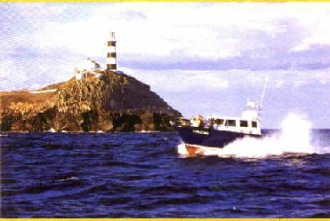![]()
-Claybird
Shooting
-Fishing
-Golf
-Harbour Trips
-Horse
Riding
-Leisure
Centre
-Pottery
Workshops
-Sailing
-Scuba
Diving
-Quad Bikes
-Windsurfing
& Watersports
-Walking &
Historical Visits
![]()
-Email Us
-Reservations & Enquiries
![]()
-Tourism
-News Links
-Radio & Television

Page 2 of 3
In this century the great liner "Lusitania" en route from New York to Liverpool was lost 11.5 miles off the Old Head of Kinsale. On 7 May 1915 the vessel was hit by a German submarine torpedo. Of a total of 1,959 passengers on board 1,195 perished. For many years the exact cause of the disaster has been debated. One theory is that there was a major explosion on board the Lusitania after the torpedo hit the ship. Three of the victims of the disaster are buried in the Churchyard of St. Multose Church in Kinsale.
Even the casual visitor to Kinsale will
be captivated by its beautiful setting, with the long waterfront, narrow winding streets,
and  Compass Hill rising sharply behind the town. The Bandon river rises in
West Cork and flows east through Bandon to Innishannon, and turns south to enter the sea
at Kinsale. The old fortifications of Charles Fort and James Fort guard the narrow
entrance to Kinsale from the sea. Kinsale owes its unique character to the fact that it
was a garrison town and port of consequence for over 300 years, hence its magnificent
Georgian houses and the Dutch influence of its architecture. It was also in the days of
sail, the natural landfall for all ships from the continent and the Americas. The flat of
the town, from the Coal Quay at the Trident, Denis Quay, the gardens of Actons, the Short
Quay behind the Temperance Hall and the Long Quay running up to the White House, were all
filled in later, and the Pier road built. The original town market and focal centre was on
the level of St. Multose Church, Desmond Castle, and the Courthouse with narrow streets
and quays radiating from it.
Compass Hill rising sharply behind the town. The Bandon river rises in
West Cork and flows east through Bandon to Innishannon, and turns south to enter the sea
at Kinsale. The old fortifications of Charles Fort and James Fort guard the narrow
entrance to Kinsale from the sea. Kinsale owes its unique character to the fact that it
was a garrison town and port of consequence for over 300 years, hence its magnificent
Georgian houses and the Dutch influence of its architecture. It was also in the days of
sail, the natural landfall for all ships from the continent and the Americas. The flat of
the town, from the Coal Quay at the Trident, Denis Quay, the gardens of Actons, the Short
Quay behind the Temperance Hall and the Long Quay running up to the White House, were all
filled in later, and the Pier road built. The original town market and focal centre was on
the level of St. Multose Church, Desmond Castle, and the Courthouse with narrow streets
and quays radiating from it.